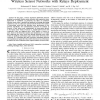Free Online Productivity Tools
i2Speak
i2Symbol
i2OCR
iTex2Img
iWeb2Print
iWeb2Shot
i2Type
iPdf2Split
iPdf2Merge
i2Bopomofo
i2Arabic
i2Style
i2Image
i2PDF
iLatex2Rtf
Sci2ools
ICC
2009
IEEE
2009
IEEE
On the Impact of Correlation on Distributed Detection in Wireless Sensor Networks with Relays Deployment
—In this paper, a binary hypothesis distributed detection problem in correlated wireless sensor networks with cooperative relays deployment is considered. In particular, the effect of correlation between sensor nodes is modeled and analyzed in Rayleigh flat fading channels in order to explore the natural tradeoffs between the number of sensor/relay nodes and the detection error performance in the network. Specifically, two communication protocols are utilized; in Protocol I, each sensor node communicates its observation directly to the fusion center while in Protocol II, Amplify-and-Forward (AF) cooperative relays are deployed and a fewer number of sensors is used. Based on the theoretical analysis and simulations, it is revealed that employing less sensor nodes and instead deploying relay nodes results in significant performance gains under strict network power constraint. It is concluded that with cooperative distributed detection and exploitation of spatial diversity, better de...
| Added | 21 May 2010 |
| Updated | 21 May 2010 |
| Type | Conference |
| Year | 2009 |
| Where | ICC |
| Authors | Mohammed W. Baidas, Ahmed S. Ibrahim, Karim G. Seddik, K. J. Ray Liu |
Comments (0)

